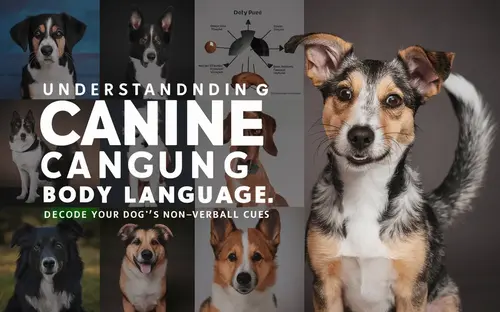As devoted dog owners, we share an incredible bond with our canine companions. However, despite our close relationship, there often exists a communication barrier – our furry friends cannot verbalize their thoughts, feelings, and needs in the same way we can. This is where understanding canine body language becomes invaluable, allowing us to decode the non-verbal cues our dogs use to express themselves.
From subtle tail wags to various facial expressions, our pups are constantly sending us signals about their emotional state and intentions. By learning to interpret these cues, we can not only deepen our connection with our four-legged friends but also ensure their well-being and address any potential issues before they escalate.
So, let’s embark on a journey to unravel the fascinating world of canine body language, empowering you to become a fluent translator of your pup’s non-verbal communication.
Tail Talks: Deciphering the Wagging Wonder
One of the most obvious and widely recognized forms of canine body language is the tail wag. However, contrary to popular belief, not all wags are created equal. The position, speed, and intensity of a dog’s tail movement can convey a range of emotions, from excitement and happiness to fear and aggression.
The Friendly Wag
A loose, wide-sweeping wag with the tail held at or slightly below the level of the spine is often a sign of a happy, relaxed dog. This type of wag is typically accompanied by a soft, wiggly body and a gentle facial expression, indicating your pup is content and approachable.
The Stiff Wag
In contrast, a stiff, tense wag with the tail held high and rigid can signify an aroused or potentially aggressive state. If you notice this type of wag, especially in combination with a tense body, raised hackles, or hard stare, it’s best to give your dog some space and avoid direct eye contact or confrontation.
The Low Wag
A low, tucked-under wag is often a sign of fear, anxiety, or submission. If your pup is exhibiting this type of wag, along with a lowered body posture and averted gaze, they may be feeling uncomfortable or threatened in their current situation. Approach with caution and aim to remove them from the environment or trigger causing their distress.
Facial Expressions: Reading Your Dog’s Emotions
Just like humans, dogs use a variety of facial expressions to communicate their emotional state and intentions. From the position of their ears to the intensity of their gaze, paying attention to these subtle cues can provide valuable insight into your pup’s mindset.
The Relaxed Face
A relaxed, soft facial expression with slightly squinty eyes and a slightly opened mouth is a good indicator that your dog is feeling calm and content. This is the ideal facial expression you want to see when interacting with your pup, as it signals their comfort and trust in the situation.
The Tense Face
On the flip side, a tense facial expression with hard, wide-open eyes, a tightly closed mouth, and flattened ears can signify fear, anxiety, or potential aggression. If you notice this expression, especially in combination with other tense body language, it’s best to give your dog some space and avoid any potentially threatening actions or confrontations.
The Whale Eye
Another subtle facial cue to watch for is the “whale eye” or “half-moon eye,” where the whites of your dog’s eyes are visible as they look away or to the side. This expression often indicates discomfort, anxiety, or a potential conflict brewing, and it’s wise to proceed with caution or remove your pup from the situation altogether.
Body Posture: Reading the Whole Picture
While tail wags and facial expressions can provide valuable insights, it’s essential to consider your dog’s overall body posture when decoding their non-verbal communication. A dog’s stance, muscle tension, and body orientation can convey a wealth of information about their emotional state and intentions.
The Playful Bow
One of the most recognizable and adorable body postures is the play bow, where your pup’s front end is lowered to the ground with their rear end in the air. This unmistakable invitation to play is often accompanied by a wiggling body, relaxed facial expression, and a loose, friendly wag.
The Tense Stance
In contrast, a tense, rigid body posture with raised hackles, a stiff tail, and forward-leaning stance can indicate potential aggression or defensiveness. If you notice this posture, especially in combination with hard eye contact or growling, it’s best to avoid any direct confrontation and give your dog space to calm down.
The Fearful Crouch
A lowered body posture with a tucked tail, flattened ears, and averted gaze is a clear sign of fear or submission. If your pup assumes this posture, it’s important to avoid any actions that could further escalate their distress, such as looming over them or making direct eye contact. Instead, create space and allow them to approach you on their own terms when they feel more comfortable.
By understanding the nuances of canine body language, you can unlock a deeper level of communication and connection with your furry friend. Remember, every dog is an individual, and their body language may vary based on their personality, breed, and life experiences. With patience, observation, and a willingness to learn, you’ll soon become fluent in the non-verbal cues that guide your pup’s actions and emotions.
So, the next time your dog wags their tail, perks up their ears, or strikes a playful pose, take a moment to truly observe and appreciate the intricate language they’re using to communicate with you. After all, decoding these non-verbal signals is the key to fostering a harmonious, mutually rewarding relationship with your canine companion.




